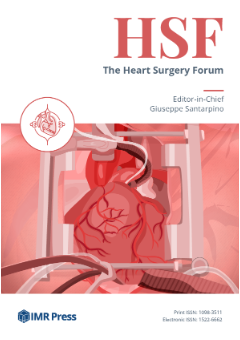Announcements
The Heart Surgery Forum (HSF) is published by IMR Press from Volume 28 Issue 9 (2025). Previous articles were published by another publisher under the CC-BY-NC licence, and they are hosted by IMR Press on imrpress.com as a courtesy and upon agreement.
Open Access
Article
Xiphoid MIDCAB: Report of the Technique and Experience with a Less Invasive MIDCAB Procedure
Show Less
Affiliation
1
Washington Hospital Center, Washington Adventist Hospital, Washington, DC, USA
2
The Benetti Institute, Buenos Aires, Argentina
Heart Surg. Forum 1999, 2(1),
77–81;
Published:
1 March 1999
Abstract
Background: Coronary bypass surgery on the beating heart has been in existence since the inception of coronary revascularization. The advent and evolution of the heart-lung machine and cardioplegia have greatly advanced and expanded the realm of bypass surgery, allowing surgeons to perform precise coronary anastomoses in a still field of the arrested heart. The minimally invasive direct coronary artery bypass (MIDCAB) has been used primarily for grafting the left internal mammary artery (LIMA) to left anterior descending artery (LAD) and is gaining acceptance as a less invasive option. Dr. Frederico Benetti in Argentina championed the resurgence of beating heart surgery in 1985, and pioneered the left anterior thoracotomy MIDCAB procedure, which he has further refined to a xiphoid approach. The xiphoid incision is a simpler, less painful approach than that through a left anterior thoracotomy.Methods: An incision is made through the xiphoid and, if necessary, into the tip of the sternum allowing the left side of the chest to be elevated. The distal LIMA is identified and dissected proximally to about the third interspace to give enough distance for a tensionless anastomosis. The pericardium is opened and the heart positioned to expose the LAD. Local stabilization for the LAD is obtained and the LIMA-to-LAD anastomosis is performed.Results: The xiphoid MIDCAB approach was used for LIMA-to-LAD anastomosis in ten patients ranging in age f rom 52 to 86 years (mean age 73 years). Three patients underwent angioplasty of additionally obstructed vessels (so-called hybrid procedures) following initial MIDCAB. Despite high preoperative-risk profiles and Parsonnet scores, there were no deaths. However, two of the three hybrid patients had major complications resulting in a prolonged hospital stay.Conclusions: Initial clinical experience with xiphoid MIDCAB proves it is a feasible alternative to intercostal MIDCAB with the possible advantages of reduced pain and chest wall complications. Further investigation into this surgical approach is warranted.

